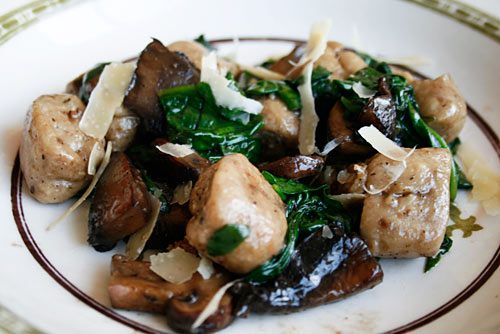Gnocchi Fundamentals

A well made plate of gnocchi should be delicate enough to be described as tender, yet sturdy enough to hold it’s own when combined with sauce. Gnocchi are basically dumplings, and can be made of almost any ingredients that can be formed into a dough. Gnocchi, (pronounced NYOK-ee) are made in most regions in Italy, although they are generally made with different ingredients in each. For example, on the island of Sardinia, you can find tiny saffron flavored potato gnocchi, while in the Alto Adige in the mountains up near Austria; they are often made with breadcrumbs.
In other regions you can find gnocchi made with everything from semolina, spinach, ricotta, chestnut flour, squash, buckwheat flour or the most common, the potato. They can be flavored with beets, saffron or herbs. Some gnocchi are round while others are oval and grooved to hold the sauce.
If you have never experienced a really good dish of gnocchi, you have missed a special treat. Luckily gnocchi can easily be made at home and are in fact quicker to make than homemade pasta. If you are a beginner to gnocchi making, I would suggest starting with ricotta gnocchi rather than potato. Potato gnocchi take a little more practice to get the texture right, and tend to be heavier as they are often overworked.
A tip I was given when I first started making potato gnocchi was to add an egg to the dough which helps create dough that holds together well. With experience you soon can eliminate the egg, and create even lighter dough. You can make really make ricotta gnocchi in as little time as it takes you to boil the water to cook them in, so they can be considered Italian “fast food”. No matter which gnocchi you make, there are some basic tips to remember.
Generally when saucing your gnocchi, the simpler the gnocchi the more options for sauce. Basic potato gnocchi would partner well with almost any sauce while spinach and ricotta gnocchi generally are served with a very simple, light tomato sauce or just melted butter and cheese.
Gnocchi Tips For Preparation And Cooking:
- The amount of flour needed for the recipe depends on the moisture content of the other ingredients. I always let my ricotta drain in a sieve before I use it to my my ricotta gnocchi, and if I am using spinach I squeeze it very dry before chopping.
- Only add three quarters of the amount of flour the recipe calls for initially. The less flour you use the lighter the gnocchi you can achieve.
- Knead your gnocchi dough only as long as it takes for the ingredients to come together into a workable dough. The longer you knead, the more flour you will use, resulting in a heavier gnocchi. Remember, a light hand yields light, delicate gnocchi!
- It is a good idea if you are new to gnocchi making to test your gnocchi before you prepare the whole batch. Drop a couple of gnocchi into boiling water and remove as soon as they come to the surface. If they fall apart, knead in a little more flour. If they hold up well, continue cutting the rest of your gnocchi.
- To cook gnocchi, always use a large pot of boiling, salted water, and remove them as soon as they float to the surface. If you overcook gnocchi they will turn to mush.
- I generally do not bother to create grooves in my gnocchi, but you can do this easily by gently pushing each piece of gnocchi against the tines of a fork.
- Gnocchi don’t keep well at room temperature; so if you are not cooking them right away, place them on a lightly floured baking sheet in the refrigerator. I would not keep any type of gnocchi in the refrigerator longer than a few hours. Semolina gnocchi are the exception to this rule as they are cut and assembled in a dish before baking, and will keep well covered in the refrigerator. Generally gnocchi don’t freeze well unless they have a good deal of flour added, which means they will not be as delicate as good gnocchi should be. Since you can prepare them so quickly, it is easier to make them fresh each time.